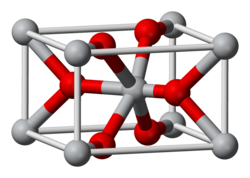Top Qs
Timeline
Chat
Perspective
Iridium(IV) oxide
Chemical compound From Wikipedia, the free encyclopedia
Remove ads
Iridium(IV) oxide, IrO2, is the only well-characterised oxide of iridium. It is a blue-black solid, used with other rare oxides to coat anodes.
Remove ads
Synthesis
As described by its discoverers, it can be formed by treating the green form of iridium trichloride with oxygen at high temperatures:
- 2 IrCl3 + 2 O2 → 2 IrO2 + 3 Cl2
A hydrated form is also known.[1]
Structure
The compound adopts the TiO2 rutile structure, featuring six coordinate iridium and three coordinate oxygen.[2] It forms a tetragonal lattice with lattice parameters of 4.5Å and 3.15Å.[3]
Mechanical properties
Oxide materials are typically hard and brittle.[4] Indeed, iridium oxide does not easily deform under stress,[5] instead cracking easily.[6] Measured deflections of a thin, cantilevered iridium oxide film indicate a Young’s modulus of 300 ± 15 GPa,[5] substantially lower than the Young's modulus of metallic iridium (517 GPa).[7]
Applications
Iridium dioxide can be used to make coated electrodes[8] for industrial electrolysis or as microelectrodes for electrophysiology.[9] In electrolytic applications, IrO2 films evolve O2 efficiently.[10]
Electrode manufacture typically requires high-temperature annealing.[11]
Fracture and delamination are well-known problems when fabricating devices that incorporate iridium oxide film. One cause of delamination is lattice mismatch between iridium oxide and the substrate. Sputtering iridium oxide on a liquid crystal polymer has been proposed to avoid mismatch,[12] but sputtered films spontaneously delaminate during cyclic voltammetry if the maximum potential bias exceeds 0.9 V.[13]
Remove ads
References
Wikiwand - on
Seamless Wikipedia browsing. On steroids.
Remove ads

